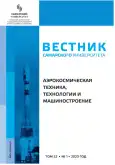Verification of a transonic stage CFD model for assessing the erosion wear influence on the operation of the axial compressor
- Authors: Blinov V.L.1, Zubkov I.S.1
-
Affiliations:
- Ural Federal University
- Issue: Vol 22, No 1 (2023)
- Pages: 51-62
- Section: MECHANICAL ENGINEERING
- URL: https://journal-vniispk.ru/2542-0453/article/view/145833
- DOI: https://doi.org/10.18287/2541-7533-2023-22-1-51-62
- ID: 145833
Cite item
Full Text
Abstract
The paper presents the results of one of the stages of creating a model of assessing and forecasting the operating characteristics of a transonic compressor due to erosive wear. A numerical model of a transonic compressor stage is constructed and verified to substantiate its applicability in calculating various degrees of blade erosive wear. The article contains a review of the basic approaches for turbulence simulation, their application area and basic features connected with 3D-flow simulation in turbomachines. The parameters and settings of the numerical model are shown. The CFD-obtained results are presented and compared with the experimental data and results of other researchers. By this comparison the accuracy of the CFD-obtained overall performance and the quality of modeling local processes are determined. Possible ways of improving the model’s accuracy are also specified.
About the authors
V. L. Blinov
Ural Federal University
Author for correspondence.
Email: v.l.blinov@urfu.ru
Candidate of Science (Engineering), Associate Professor of the Department of Turbines and Engines
Russian FederationI. S. Zubkov
Ural Federal University
Email: lamqtada@gmail.com
Student of the Department of Turbines and Engines
Russian FederationReferences
- Garbaruk A.V., Strelets M.Kh., Shur M.L. Modelirovanie turbulentnosti v raschetakh slozhnykh techeniy: uchebnoe posobie [Modeling of turbulence in calculations of complex flows. Tutorial]. St. Petersburg: Polytechnic University Publ., 2012. 88 p.
- Reynolds O. On the dynamical theory of incompressible viscous fluids and the determination of the criterion. Phylosophical Transactions of the Royal Society. 1895. P. 123-164.
- Cumpsty N.A. Some lessons learned. Journal of Turbomachinery. 2010. V. 132, Iss. 4. doi: 10.1115/1.4001222
- Versteeg H., Malalasekera W. An introduction to computational fluid dynamics: the finite volume method. New York: Longman Scientific & Technical, 1996. 257 p.
- Wilcox D.C. Turbulence modeling for CFD. California: Griffin Printing, 1993. 536 p.
- Lapin Yu.V., Pospelov V.A. Turbulent boundary layer at a flat plate. High Temperature. 1995. V. 33, Iss. 3. P. 421-428.
- Garbaruk A.V., Lapin Yu.V., Strelets M.Kh. Simple algebraic model of turbulence for the calculation of turbulent boundary layer with adverse pressure gradient. High Temperature. 1999. V. 37, Iss. 1. P. 82-86.
- Labusov A.N., Lapin Yu.V. Four-parameter two-layer algebraic model of transition boundary layer on a flat plate. High Temperature. 1996. V. 34, Iss. 6. P. 928-934.
- Cebeci T., Smith A.M.O. Analysis of turbulent boundary layers. N.Y.: Academic Press, 1974. 422 p.
- Gulyaev A.N., Kozlov V.E., Secundov A.N. A universal one-equation model for turbulent viscosity. Fluid Dynamics. 1993. V. 28, Iss. 4. P. 485-494. doi: 10.1007/BF01342683
- Spalart P.R., Allmaras S.R. One-equation turbulence model for aerodynamic flows. Proceedings of the 30th Aerospace Sciences Meeting and Exhibit (January, 06-09, 1992, Reno, NV, U.S.A). doi: 10.2514/6.1992-439
- Turbulence modeling resource. NASA Langley Research Center. Available at: https://turbmodels.larc.nasa.gov/
- CFD validation for propulsion system components / ed. by J. Dunham. AGARD Advisory Report 355. AGARD, 1998. 100 p.
- Pinto R.N., Afzal A., D’Souza L.V., Ansari Z., Mohammed Samee A.D. Computational fluid dynamics in turbomachinery: a review of state of art. Archives of Computational Methods in Engineering. 2016. V. 24, Iss. 3. P. 467-479. doi: 10.1007/s11831-016-9175-2
- Reid L., Moore R.D. Design and overall performance of four highly loaded, high-speed inlet stages for an advanced high-pressure-ratio core compressor. Lewis Research Center, 1978. 132 p.
- Blinov V.L., Zubkov I.S. The developing of the digital model of blade row for assessing the defects’ influence to performance of the axial compressor as a part of gas turbine unit. Compressors and Pneumatics. 2021. No. 1. P. 18-25. (In Russ.)
- Menter F.R. Two-equation eddy-viscosity turbulence models for engineering applications. AIAA Journal. 1994. V. 32, Iss. 8. P. 1598-1605. doi: 10.2514/3.12149
- Taylor J.V., Miller R.J. Competing 3D mechanisms in compressor flows. Proceedings of the ASME Turbo Expo 2015: Turbine Technical Conference and Exposition (June, 15-19, 2015, Montreal, Quebec, Canada). V. 2A: Turbomachinery. doi: 10.1115/GT2015-43322
- Suder K.L., Celestina M.L. Experimental and computational investigation of the tip clearance flow in a transonic axial compressor rotor. Journal of Turbomachinery. 1996. V. 118, Iss. 2. P. 218-229. doi: 10.1115/1.2836629
- Denton J.D. Lessons from rotor 37. Journal of Thermal Science. 1997. V. 6, Iss. 1. doi: 10.1007/s11630-997-0010-9
- Hah C. Large eddy simulation of transonic flow field in NASA Rotor 37 // Proceedings of the 47th AIAA Aerospace Sciences Meeting including the New Horizons Forum and Aerospace Exposition (January, 05-08, 2009, Orlando, Florida). doi: 10.2514/6.2009-1061
- Blinov V.L., Zubkov I.S., Iskortsev E.Yu., Belyaev O.V., Plishkin P.I. Special aspects of numerical simulation of a two-stage axial-flow compressor with defective blades. Vestnik of Samara University. Aerospace and Mechanical Engineering. 2021. V. 20, no. 4. P. 7-19. (In Russ.). doi: 10.18287/2541-7533-2021-20-4-7-19
- Ameri A.A., Arnone A. Prediction of turbine blade passage heat transfer using a zero and a two-equation turbulence model. Proceedings of the ASME International Gas Turbine and Aeroengine Congress and Exposition (June, 13-16, 1994, The Hague, Netherlands). doi: 10.1115/94-gt-122
- Yamada K., Furukawa M., Inoue M., Funazaki K.I. Numerical analysis of tip leakage flow field in a transonic axial compressor rotor. Proceedings of the International Gas Turbine Congress (November, 2-7, 2003, Tokyo).
- Veres J.P. Axial and centrifugal compressor mean line flow analysis. Proceedings of the 47th AIAA Aerospace Sciences Meeting Including the New Horizons Forum and Aerospace Exposition (January, 5-8, 2009, Orlando, Florida). doi: 10.2514/6.2009-1641
- Aviatsionnye GTD v nazemnykh ustanovkakh / pod red. V.V. Shashkina [Aviation gas turbine engines in ground-based installations / ed. by V.V. Shashkin]. Moscow: Mashinostroenie Publ., 1984. 228 p.
Supplementary files









